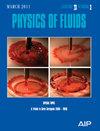Meso-scale investigation on the permeability of frozen soils with the lattice Boltzmann method
IF 4.3
2区 工程技术
Q1 MECHANICS
引用次数: 0
Abstract
Complex composition and intricate pore-scale structure of frozen soils poses significant challenges in reliably and efficiently obtaining their permeability. In this study, we propose a modified quartet structure generation set (QSGS) numerical tool for generating frozen soils and present the development of a computational simulation code based on the multiple-relaxation-time lattice Boltzmann method (LBM). In the modified QSGS, the arc-shaped water-ice interface is depicted, and the influence of pore-scale geometry on freezing temperature is considered. The validity of combining the proposed QSGS model and the LBM code is proved by comparing calculated results to analytical and experimental results of porous media. Our objective was to investigate the effects of soil features, including porosity, grain diameter, shape anisotropy of soil particles, and ice content on the intrinsic permeability of frozen soil. Additionally, we examined the relationship between these features and the specific surface area and tortuosity. Numerical results show that the intrinsic permeability of frozen soils increases with increasing porosity, larger granular diameter, and anisotropy, which is identical with the pressure gradient. The presence of ice led to clogging flow pathways and drastically decreased the intrinsic permeability, which is significantly less than unfrozen soil with same effective porosity. This study provides a useful tool to investigate the intricate interplay between the pore-scale structure and the intrinsic permeability of frozen soils.用晶格玻尔兹曼法对冻土的渗透性进行中尺度研究
冻土成分复杂,孔隙尺度结构错综复杂,给可靠有效地获取其渗透率带来了巨大挑战。在本研究中,我们提出了一种用于生成冻土的改进型四元结构生成集(QSGS)数值工具,并介绍了基于多松弛时间晶格玻尔兹曼法(LBM)的计算模拟代码的开发情况。在改进的 QSGS 中,描绘了弧形水冰界面,并考虑了孔隙尺度几何形状对冻结温度的影响。通过将计算结果与多孔介质的分析和实验结果进行比较,证明了将所提出的 QSGS 模型与 LBM 代码相结合的有效性。我们的目标是研究土壤特性(包括孔隙度、颗粒直径、土壤颗粒形状各向异性和含冰量)对冻土内在渗透性的影响。此外,我们还研究了这些特征与比表面积和迂回度之间的关系。数值结果表明,冻土的内在渗透性随着孔隙度、颗粒直径增大和各向异性的增加而增加,这与压力梯度相同。冰的存在导致流动通道堵塞,本征渗透率急剧下降,明显低于有效孔隙度相同的未冻结土壤。这项研究为研究冻土孔隙尺度结构与固有渗透性之间错综复杂的相互作用提供了有用的工具。
本文章由计算机程序翻译,如有差异,请以英文原文为准。
求助全文
约1分钟内获得全文
求助全文
来源期刊

Physics of Fluids
物理-力学
CiteScore
6.50
自引率
41.30%
发文量
2063
审稿时长
2.6 months
期刊介绍:
Physics of Fluids (PoF) is a preeminent journal devoted to publishing original theoretical, computational, and experimental contributions to the understanding of the dynamics of gases, liquids, and complex or multiphase fluids. Topics published in PoF are diverse and reflect the most important subjects in fluid dynamics, including, but not limited to:
-Acoustics
-Aerospace and aeronautical flow
-Astrophysical flow
-Biofluid mechanics
-Cavitation and cavitating flows
-Combustion flows
-Complex fluids
-Compressible flow
-Computational fluid dynamics
-Contact lines
-Continuum mechanics
-Convection
-Cryogenic flow
-Droplets
-Electrical and magnetic effects in fluid flow
-Foam, bubble, and film mechanics
-Flow control
-Flow instability and transition
-Flow orientation and anisotropy
-Flows with other transport phenomena
-Flows with complex boundary conditions
-Flow visualization
-Fluid mechanics
-Fluid physical properties
-Fluid–structure interactions
-Free surface flows
-Geophysical flow
-Interfacial flow
-Knudsen flow
-Laminar flow
-Liquid crystals
-Mathematics of fluids
-Micro- and nanofluid mechanics
-Mixing
-Molecular theory
-Nanofluidics
-Particulate, multiphase, and granular flow
-Processing flows
-Relativistic fluid mechanics
-Rotating flows
-Shock wave phenomena
-Soft matter
-Stratified flows
-Supercritical fluids
-Superfluidity
-Thermodynamics of flow systems
-Transonic flow
-Turbulent flow
-Viscous and non-Newtonian flow
-Viscoelasticity
-Vortex dynamics
-Waves
 求助内容:
求助内容: 应助结果提醒方式:
应助结果提醒方式:


